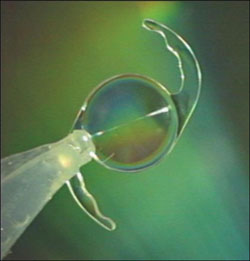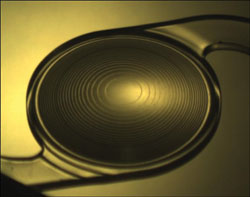New achromatic optic lens improves visual quality, depth of field
The lens eliminates chromatic aberration, a major limiting factor for foveal vision, a clinician says.
Click Here to Manage Email Alerts
A new monofocal IOL pioneers the concept of improving visual quality by eliminating chromatic aberration.
 Jorge L. Alió |
“Colors have different wavelengths, and standard IOLs normally don’t have the capability of focusing them to the same convergence point. This chromatic dispersion creates a distortion of the retinal image called chromatic aberration, a major limiting factor for foveal vision,” Jorge L. Alió, MD, PhD, OSN Europe Edition Editorial Board Member, said.
In collaboration with Hanita lenses, Dr. Alió and a team of researchers formed by Norberto López-Gil, PhD, and Robert Montés-Micó, OD, PhD, in Alicante, Spain, have created a new type of achromatic optic that affects the entrance of light into the eye, preventing prismatic, diffractive and refractive pollution of the image.
The elimination of chromatic aberration should increase image contrast, thereby increasing contrast sensitivity function and visual acuity, Dr. Alió said.
 Figure 1: Achromatizing lens design. |
 Figure 2: Innovative lens optic. Images: Alió JL
|
New concept
The achromatic Hanita is the first lens designed with this concept and may soon be available on the European market. After preliminary assessments, it is currently undergoing clinical evaluation at the Vissum Institute. A multicenter clinical trial will follow shortly.
“Simulations of clinical outcomes have been carried out on the optical bench at Murcia University by Norberto López-Gil. We have been able to assess and confirm the capability of the lens not only to improve visual acuity and contrast sensitivity, but also to increase depth of field up to 1.5 D because of the increased quality of retinal image,” Dr. Alió said.
The achromatic Hanita is a monofocal lens, but it can provide presbyopic patients with a fair amount of near correction.
The lens is acrylic and has loop haptics. The 6-mm optic combines refractive and diffractive surfaces, both aspheric. Dr. Alió said this technology is not used for multifocality but for dioptric power modulation, and it allows the lens to be extremely thin. No change in thickness is required for increased power.
Implantation is carried out with an injector, through a 2.5-mm incision, he said.
“We have implanted the lens in our first patients and will soon be able to disclose our results,” Dr. Alió said. – by Michela Cimberle

- Jorge L. Alió, MD, PhD, can be reached at Vissum Institute, Avenida de Denia, s/n, 03016 Alicante, Spain; +34-965150025; fax: +34-965151501; e-mail: jlalio@vissum.com.
- Disclosure: Dr. Alió is a medical investigator for Hanita Lenses and a patent holder.
